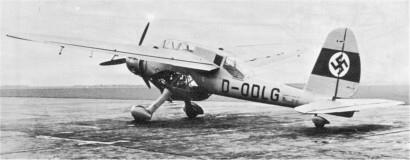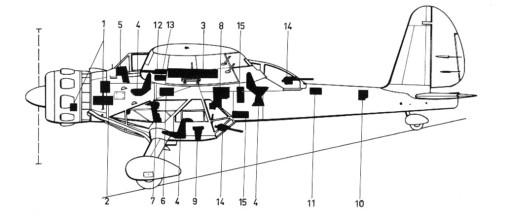1 Rb 50/30, Radio Telefunken 276dF, Revi 3a
Development of this aircraft dates back to the year 1936 when the RLM issued a specification to the aircraft industry calling for a plane specially suited to the short-range reconnaissance role. This specification was initially taken up by Arado, Blohm & Voss (Hamburger Flugzeugbau Division), Focke- Wulf, and Henschel. Each of these firms was able to base on previous respective designs and experience for this specific aircraft type in order to submit further development and alternative studies to the RLM within a short time.
As with previous construction orders, specific conditions suited to the bidders were attached to the development contracts granted. Thus, for Focke-Wulf and Hamburger Flugzeugbau an extended specification for the design of a multi-purpose plane was put into the fore, while Henschel and Arado had to stick to the purpose of short-range reconnaissance with tactical tasks for the project. As a final result of this specification, apart from a multitude of projects the types Arado Ar 198, Blohm & Voss Ha 141, Focke-Wulf FW 189, and Henschel Hs 126 were approved for construction. Whatever the reasons underlying this decision may have been, for the Arado works the contract meant the development of an unorthodox aircraft design that came closest to the specifications issued.
This design was to replace the Heinkel He 46 already in service with the Luftwaffe by a potent combat plane conceived according to the latest technical know-how. This included on the one hand the use of a powerful engine, good characteristics over the speed range, optimum vision for the crew and, on the other hand, protective and defensive possibilities against air and ground targets according to the mission.
After various changes of the basic concept a contract for a preproduction series AradoAr 198A-0 was finally granted in July, 1937, at a time when Henschel was already fully engaged in the series production. For the Ar 198 a crew of three, consisting of pilot, gunner/radio operator, and observer, was planned. Due to the required good vision and high speed a fully-enclosed crew compartment was laid down in the design. Tactical reconnaissance operations put special emphasis on ground vision. The observer's post therefore, was positioned below the wing plane for unobstructed vision, while pilot and gunner were provided with optimum operating conditions according to their respective tasks in an extensively glazed cabin above the wing plane. In this generously laid-out crew compartment there was an accessible connection to each position which resulted in good,communication between crew members. Finally, it was the extensive glazing of the crew compartment that earned the plane the nickname "Flying Aquarium".
The entire forward fuselage structure, inclusive of the crew compartment, was of steel tube construction whereby the engine bearer was included in this construction. Formers, light-metal fillets, and the light-metal skin, allowed for an aerodynamically advantageous shape. The rear fuselage was of closed all-metal monocoque construction purely as a tail-boom with no equipment for tactical missions installed.
The question of power plant turned into a problem at first with regards to the completion of the first three experimental machines. According to the plans submitted a high-rated engine of 1,000 h.p. at take-off was projected, preference to be given to the air-cooled standard radial power plant BMW 132. The other projected versions submitted with DaimlerBenz DB 600, DB 601 A, or Jumo 210 G engines were disregarded owing to the difficulties in obtaining these engines. When it became obvious that a delay in obtaining the BMW 132 engine would cause a delay in the program, too, the slightly lower powered Bramo 323 A-1 of the Brandenburgische Motorenwerke, later BMW, in its air-cooled carburettor radial version of 900 h.p. at take-off was finally installed.
The first flight of the Arado 198 V1 took place from the factory airfield at Warnemünde in early March of 1938 after continued difficulties in obtaining the engines because in the meantime this engine had been re-designed to fuel injection. Already during the first flights which, in general, could be considered satisfactory, an instability in the projected low-speed range about all axes was noticed. It was thought that this was due to the large extension of the lower fuselage and consequently the layout of this part was markedly changed for the second and third prototype. In order to correct the flight characteristics the wings of the Ar 198 V1 were fitted with automatic slats, this resulted in noticeable improvement but still a lot of experience was demanded of the pilot.
Further criticism arose in view of the high costs of production, the complex assembly, and the insufficient production capacity. This finally caused the Technical Office to stop the entire development of the Arado Ar 198 for mass-production; the Henschel Hs 126, already delivered in great quantity, was to be the sole tactical reconnaissance plane issued to the Luftwaffe.
Continued evaluation of the type Ar 198 with the Arado program, however, was not cancelled by that decision. The second prototype was also completed but was turned over to the Luftwaffe Flight Test Center at Rechlin. Soon after some very sucessful test flights this aircraft crashed on the landing approach when the starboard automatic slat came off, damaging the wing and forcing the pilot to make an emergency landing on rough ground. Damage to the airframe was such that restoration of the machine was not carried out. The Arado Ar 198 V1, however, after the elimination of a few faults, was flown for a long time with increasing enthusiasm on the part of its assigned crew. Because of its good downward vision the military equipment was replaced by special surveying equipment and the aircraft transferred to a special unit with Weser Flugzeugbau at Bremen taking over the maintenance.
Flying weight
3113,3
Flying weight
| Type |
3-seated close reconnaissance and army co-operation aircraft |
| Engine |
1 BRAMO 323 A-1 Fafnir , VDM adjustable pitch 3-blade clockwise rotation Ø 3.60 m |
| Dimensions |
Length 11.80 m, height 4.60 m, span 14.90 m, wing area 35.20 m2 |
| Weights |
Empty 2180 kg, loaded 2327 kg, max flying weight 3600 kg, wing loading 86.50 kg/m2, fuel 540 l |
| Performance |
Max. speed at sea level 317 km/h, at 3500 m 360 km/h, cruising speed at 3500 m 260 km/h, stall speed at sea level 118 km/h, climb to 1000 m 3.4 min., to 2000 m 7.2 min., to 3000 m 11.2 min., service ceiling 7400 m, range with max. fuel 960 km, with max. load 780 km, landing speed with fully extended flaps 90 km/h, required runway fully loaded 310 m, to 20 m 600 m, required runway for landing from 20 m altitude 510 m |
| Armament |
(Planned) 2 MG 17 fixed in the wings, dorsal position 1 MG 15 in a Arado "Kurbel"-mounting (movable 80° up and 45° to left and right), 1 MG 15 firing backwards in the lower part of cockpit (movable 85° downwards and 70° to the left and right), Bombload : 4 50 kg bombs under the wings |
| Type |
Werk.Nr |
Registration |
History |
| V1 |
2651 |
D-ODLG |
First flight March 1938 Because of its good downward vision the military equipment was replaced by special surveying equipment and the aircraft transferred to a special unit with Weser Flugzeugbau at Bremen taking over the maintenances |
| V2 |
2652 |
|
Delivered to Rechlin for testing but crashed after only a few flights during landing |
| V3 |
2653 |
D-OHHS |
Rebuilt fr testing Fwler flaps and mvable ailerns, type Rebeski. Wing area culde be incresded trm 38,2 up t 46,0 m2 |



| Close Reconnaissance Aircraft |
Army Co-operation Aircraft |
| Pos. |
Equipment |
Weight, kg |
Pos. |
Equipment |
Weight, kg |
| 1 |
Equipment for lights |
6,40 |
1 |
Equipment for lights |
6,40 |
| 2 |
Oil |
38,0 |
2 |
Oil |
38,0 |
| 3 |
Fuel |
420 |
3 |
Fuel |
360 |
| 4 |
Crew 3 |
260 |
4 |
Crew 3 |
260 |
| 5 |
Pilots instruments |
12,20 |
5 |
Pilots instruments |
12,20 |
| 6 |
Oxygen |
8,70 |
6 |
Oxygen |
8,70 |
| 7 |
Observers instruments |
6,30 |
7 |
Observers instruments |
6,30 |
| 8 |
Radio |
74,80 |
8 |
Radio |
74,80 |
| 9 |
Camera |
45,70 |
9 |
Camera |
45,70 |
| 10 |
Master compass |
2,90 |
10 |
Master compass |
2,90 |
| 11 |
First Aid |
2,70 |
11 |
First Aid |
2,70 |
| 12 |
2 MG 17 |
20,40 |
12 |
2 MG 17 |
20,40 |
| 13 |
250 rounds of ammunition |
7,40 |
13 |
250 rounds of ammunition |
7,40 |
| 14 |
MG 15 |
13,0 |
14 |
2 MG 15 |
26,0 |
| 15 |
500 rounds of ammunition |
14,80 |
15 |
500 rounds of ammunition |
14,80 |
|
Load |
933,3 |
|
Load |
1077,0 |
|
Weight empty |
2180,0 |
|
Weight empty |
2180,0 |
|
Flying weight |
3113,3 |
|
Flying weight |
3257,6 |



